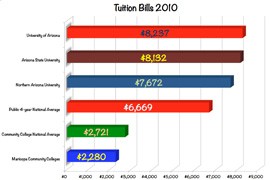Cronkite News has moved to a new home at cronkitenews.azpbs.org. Use this site to search archives from 2011 to May 2015. You can search the new site for current stories.
Report: Arizona schools posted some of nation’s biggest tuition increases
WASHINGTON – Fueled by state budget cuts to higher education, tuition increases of 49 percent at the University of Arizona and 44 percent at Arizona State University landed the two schools in the top 20 for tuition hikes from 2008 to 2010.
At ASU, in-state tuition rose from $5,661 in 2008 to $8,132 in 2010 while at the University of Arizona, in-state tuition “sticker price” rose from $5,542 to $8,237 in the same period. Nationally, the average for in-state tuition at a four-year public university in 2010 was $6,669, according to a report by the U.S. Department of Education.
But Arizona’s public universities are still reasonably affordable when compared to similarly sized schools across the country with the same scope and purpose, said Arizona Board of Regents spokeswoman Katie Paquet.
“Institution types can be vastly different, but compared to our peers we are still at the middle of the pack for tuition prices,” Paquet said.
The Education Department report, released in June, said that more than 40 states cut higher education spending last year, and the problem has been especially acute in Arizona, California and Georgia. The resulting tuition increases could put college out of reach at a time when the nation needs more college graduates, said Education Secretary Arne Duncan.
“As a nation, we need more college graduates in order to stay competitive in the global economy,” Duncan said. “But if the costs keep rising, especially at a time when family incomes are hurting, college will become increasingly unaffordable for the middle class.”
But Paquet said things are starting to turn around in the Arizona. In 2012, for the first time in 20 years, she said, both Arizona State University and the University of Arizona will be immune from tuition hikes – a result of a slight increase in state funding.
In the past four years, ASU has faced more than $200 million in state budget cuts – among the most severe reductions in the country, said Arizona State University communications director Sharon Keeler. More than $100 million of those reductions resulted in cuts, with the remainder covered, in part, by increased tuition.
“As a result of the significant budget reductions, ASU tuition rates have increased to maintain program quality and availability for ASU students,” Keeler said.
Paquet said the same is true of the university system in general, with only about half of the budget cuts made up through tuition increases and the rest made up through reductions in other areas.
In light of higher education budget cuts, Duncan said that community colleges remain one of the most consistently affordable options for higher education. Paquet said the Board of Regents has worked to increase access to higher education through the state’s community colleges.
“We have seen huge partnerships with the community colleges across the state,” she said. “Students are accepted into both the community college and the university at the same time and after they take two years at a community college, they go on to a university to complete a bachelor’s degree.”
Enrollment at community colleges has increased for three consecutive semesters, which can be attributed to their prices remaining the same, said Tom Gariepy, a spokesman for Maricopa Community Colleges.
Gariepy said tuition hikes were not the sole reason for higher enrollment, and said several elements are “conspiring” to increase student numbers.
“When the economy goes south, community college enrollment invariably increases,” he said. “And when things get tough, people feel the need to upgrade their job skills or even find a new career.”
Over the past four years, when government funding for higher education has seen the most severe cutbacks, there has been a huge surge in new ways to make higher education more affordable, Paquet said.
“We’re always looking for ways to innovate and make college more accessible for students,” she said.







